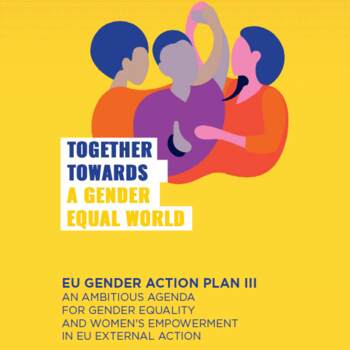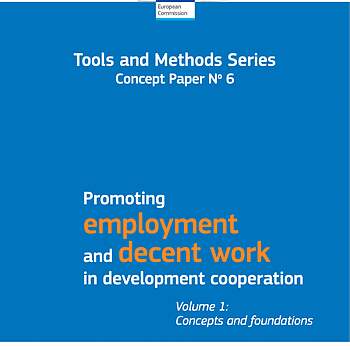EU goal on gender equality and women’s empowerment in development cooperation: 2005
The declaration on The European Consensus on Development of 2005 of the EU member states and the European Commission included a goal to ‘promote gender equality and empower women’. It was recognized that “the empowerment of women is key to all development; and gender equality should be a core part of all policy strategies”. This led to the Communication of the EC on Gender Equality and Women Empowerment in Development Cooperation, of 8 March 2007, the so-called 8th of March Communication. In order to operationalize this ‘8th of March Communication’, gender experts from the EU Member States called for a Plan of Action.
EU Gender Action Plans I and II: from 2010 to 2020
In 2010 the Council of the EU adopted its first Action Plan on Gender Equality and Women’s Empowerment in Development (2010-2015) (GAP-I), which was a joint plan for the EC and the EU member states. The Plan aimed strengthening the lead role of the EU in promoting gender equality and women's empowerment in development. This first GAP included 37 actions and 53 indicators. In 2015 the second Gender Action Plan (GAP-II) was endorsed by the EU: Measures for Gender Equality and Women's Empowerment: Transforming the Lives of Girls and Women through EU External Relations 2016-2020. This GAP-II pursued an “institutional culture shift in the European Union external relations”. Of the three thematic areas of GAP-II, one aimed to contribute to “girls’ and women's economic and social empowerment, to their active participation in the economy and to the prevention of economic exploitation”.
All GAPs foresaw an accountability system where both the EU member states and the Commission, including the EU’s diplomatic service and EU Delegations, must report annually on progress in implementing the indicators for which they are responsible. These monitoring reports represent the stock-taking exercises of what the EU is doing to promote gender equality and women’s empowerment in development cooperation.
GAP-III: from 2021 to 2025
In 2017 a New European Consensus on Development had been adopted, already placing gender equality at the core of its priorities and vital for achieving the SDGs and the whole 2030 Agenda. This contributed to an ambitious Gender Action Plan 2021-2025 (GAP III): An ambitious agenda for gender equality and women’s empowerment in EU external action. The five pillars of the GAP-III represent a gender-transformative approach that addresses the root causes of gender inequality in all external actions, including development cooperation, humanitarian support, peace and security, and trade. The key thematic areas of GAP-III include the promotion of economic and social rights and the empowerment of girls and women. Also for GAP-III objectives and indicators have been put in place to monitor the progress in implementation of GAP-III.
WEE in GAP-III
Specific actions under GAP-III to be supported by the EU and its member states to contribute to WEE include:
- Promoting decent work, equal pay and labor rights, reducing labor market segregation, boosting women’s leadership and increasing their bargaining power in economic and household decision-making
- Creating an enabling environment for women’s economic activities and access to productive resources and eco-system services, including women’s access to land, seas and oceans activities, remittances, technology, finance, safe and affordable transport options
- Universal social protection systems, and recognizing, reducing and redistributing unpaid care and domestic work by providing support for gender-responsive budgeting
- Challenging gender norms within the household and the labor market, recognizing men and boys’ responsibilities and fostering legislative developments, such as paternity leave
- Women entrepreneurship and women-led businesses, including social entrepreneurship, and their access to finance, and addressing the market’s failure to reach women
- Supporting and empowering migrant women contribute to the sustainable development of countries of origin, transit and destination through remittances, skills and knowledge
- Promoting gender equality through trade policy.
The accompanying Joint Staff Working Document specified 10 specific objectives to promote economic and social rights and empowering girls and women. To measure the achievements of these objectives, 12 impact indicators and 68 outcome indicators were defined for reporting results in terms of WEE of all external actions of the EU and its member states.
Relevance for Dutch development cooperation
As an EU member state, the Netherlands must adhere to EU policies, thus also to the EU international gender policies. Therefore, MFA has to also incorporate objectives and actions of the EU Gender Action Plans into its own policies and strategies, including by adopting corresponding targets. An important target under GAP-II (2016-2020) was that 75% of all projects and programs could be marked as G-1 (with gender equality as a significant objective) or G-2 (with gender equality as the principal objective). However, like in many other EU member states, Dutch development cooperation at that time did not achieve this.
GAP-III (2021-2021) increased this target to 85% and introduced a ground-breaking gender transformative approach, meaning that root causes of inequality have to be addressed. The policy document (titled: Do what we do best) of June 2022 of the Dutch Minister for Foreign Trade and Development Cooperation confirms that Dutch development cooperation will focus on root causes of gender inequality, such as unequal power relations, social norms and stereotypes. And with WEE strongly anchored in GAP-III, this is an extra push for Dutch development cooperation to continue pursuing WEE through its policies and actions.
The opting for a Feminist Foreign Policy in mid-2022 by the Dutch cabinet also means integrating gender equality not only in development cooperation but in all aspects of Dutch foreign policy, including in trade, which is likely to further enhance WEE.

